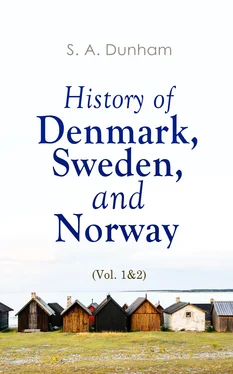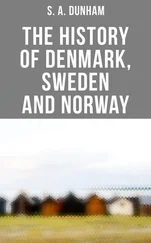We have already seen the meagre sum of information which Tacitus has bequeathed to us respecting the state of the north in his time. For many centuries afterwards, no great additions were made to it. In the fifth we learn that between the Elbe and the Baltic—no doubt, too, on both sides of that river, to some extent—were Angles, Jutes, and Saxons. Of these the first had no other seat. The second were doubtless a bastard colony from the more northern parts of the peninsula; and the last were an offset from the great Saxon confederation. The Jutes were the fewest in number; yet they were the progenitors of the men of Kent and the Isle of Wight, and of a tribe among the West Saxons. The rest of the Saxons—West, East, and South—were derived from the Saxon division of the colonists. The Angles gave their name to the people who bore it (the East Angles and Middle Angles) and likewise to the Mercians and Northumbrians. Such, according to that venerable authority the Saxon Chronicle, was the connection between these people and our island. But, reverting to the state of northern Europe after the time of Tacitus, yet before geography made us well acquainted with it, king Alfred, in his epitome of Orosius, adds some particulars which he had learned from his own inquiries. These particulars he derived from Otter, a Norwegian, and Wulfstan, a Danish seaman. The former said that he lived north of all the Northmen, in Halgoland, opposite to the west sea; that north of him there was an immense waste land, some parts of it, however, being visited by the Finns for hunting in summer and fishing in winter; that he had once sailed round the North Cape to the White Sea, and on the coast had found a people called Beormas, who spoke a kindred language with the Finns. “This Otter,” says the king, “was a rich man, according to the opinion of his own country: he had 600 tame deer, and six decoy ones, whose value in catching the wild deer was incalculable: hence these decoy deer were much esteemed by the Finns.” But this Norwegian captain had not above twenty head of horned cattle, and as many sheep and swine. The Finns paid rent in skin, feathers, whalebone, and ropes for shipping. (The proprietors of these lands were evidently Goths, the conquering tribe.) Otter further said, that the country of the Northmen (Norway) was long and narrow, cultivated on the sea coast, but to the east overlooked by wild barren mountains. Yet Finns inhabited them even in the ninth century—a proof that they were tributary to these Goths, especially as we may infer from this Norwegian’s account that they were the only people that paid rent: the dominant race were freeholders. Opposite to this country of the Northmen, in the south, was Swevland , or Sweden; and to the north, the country opposite was Cwenaland , or that portion of the region between the Gulf of Bothnia and Mount Sevo. “These Cwenas,” says Otter, “frequently assailed the Northmen, and the Northmen were no less inclined to pass the mountains against the Cwenas. From Halgoland, where Otter dwelt, to the north of the land inhabited by the Northmen, is a great distance—so great that no one could reach it by sea in a month.” To be brief, the whole course of the navigation from the extremity of Norway to the south of Jutland, is so minutely described, as to render it impossible for any one to mistake the localities intended, or to refuse credit to the relation of this old Norwegian navigator. [12]
The distinction, for which we have given some reasons, between the various tribes of the north, is now acknowledged by all the native writers, and by all foreigners, who have paid much attention to the subject. “The followers of the historic Odin,” says a living writer, “were the Sviar, known unto Tacitus under the name of Suiones; and the inhabitants whom they found in the country were another tribe of Goths, who had emigrated thither at a remote period, veiled from the eye of history. The primitive people by whom it was occupied, were the Jötnar and Dwarfs; the Feuni of Tacitus; the Skrithfiuni of Procopius, and the Cwenas and Finnas mentioned by the Norwegian navigator to king Alfred. They were gradually expelled, and driven further north, towards the arctic circle, by the Goths and Sviar, with whom they maintained perpetual war, embittered by religious rancour, often represented, in the fictions of the northern age, under the allegory of a contest between the celestial deities and the giants or evil genii.” But of this subject more hereafter, when we come to the exploits and policy of Odin. [13]
Of the Scandinavians, prior to the arrival of Odin, and, indeed, for centuries after that event, little, as far as regards their domestic history, is known. Rejecting wholly, as fabulous, the boast of native writers, that they had monarchs centuries before the foundation of Rome; we may, however, admit that they had kings—or, if the reader pleases, local judges—in time of peace, and military chieftains in war. There is reason to think that their chieftains, who assumed the regal title, were at one period, and, indeed, generally, exceedingly numerous. “At this time,” says a chronicler, speaking of the age following our Saviour’s birth, “there were many kings in the north.” Sweden had a dozen of them; Norway no fewer than eighteen; Jutland had usually two; and the various islands composing the rest of the Danish monarchy, had each one. As in the heroic age of Greece, so in that of Scandinavia, the same condition of society produced the same form of government. Of these reguli, some were probably hereditary, some elective; some were certainly principal, others tributary. This distinction was the result, first, of some fancied superiority in the family of certain princes, but in a greater degree of their superior success. In Norway, for instance, the Finnish family of Fornjoter (Forniot) was esteemed the most ancient, and was that to which all the princes of that country referred their origin. But let us not forget that little dependence is to be placed on the alleged progenitors of these reguli, or the names of the reguli themselves, or their respective order of succession, [14]or on the deeds attributed to them. All is darkness, uncertainty, contradiction. In the history of Norway, for instance, we are referred to Swedish kings as contemporary, whom the history of the latter kingdom places many generations before or after the alleged period. This is more strikingly the case in regard to the Danish and Swedish kings. In the history of the one we are referred to that of the other; yet the latter, in a majority of cases, have not one syllable on the subject. Names and events, on which the destinies of each country seems to turn, are mentioned by one class of historians, and passed over by another as having had no existence. But if so little reliance is to be placed on these regal successions, we must not lose sight of the fact, that were they and the events ascribed to them wholly fabulous (yet wholly fabulous they are not, since tradition does not so much create as amplify and distort), they would still demand our attention. Reject them, and nine tenths of northern history must be rejected with them. And these traditionary songs, which form the entire history of the north, deserve our notice in another respect—they supply us with the best, the only picture of national manners. For this reason, we shall cast a hasty glance at the more remarkable events which Saxo represents as prior to the Odinic times, but which, in fact, were subsequent.
Of the Swedish and Norwegian history, during this fabulous or mythologic, or, at best, doubtful period, we have little information beyond what is afforded us by the historian of Denmark, and he only mentions them incidentally. Not so in regard to the Danish themselves, which, thanks to his romantic bias and untiring industry, are sufficiently well known to us.
Читать дальше












